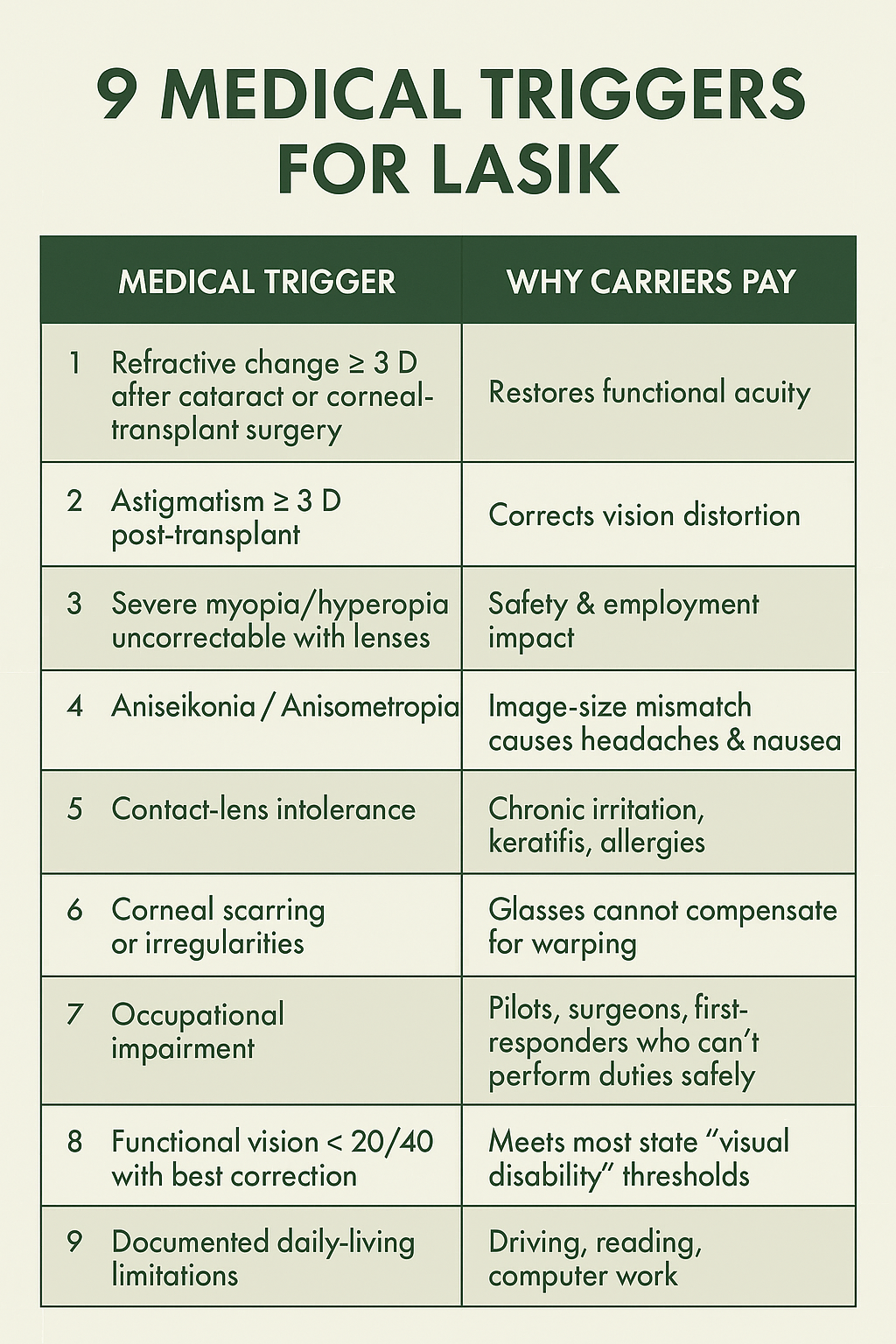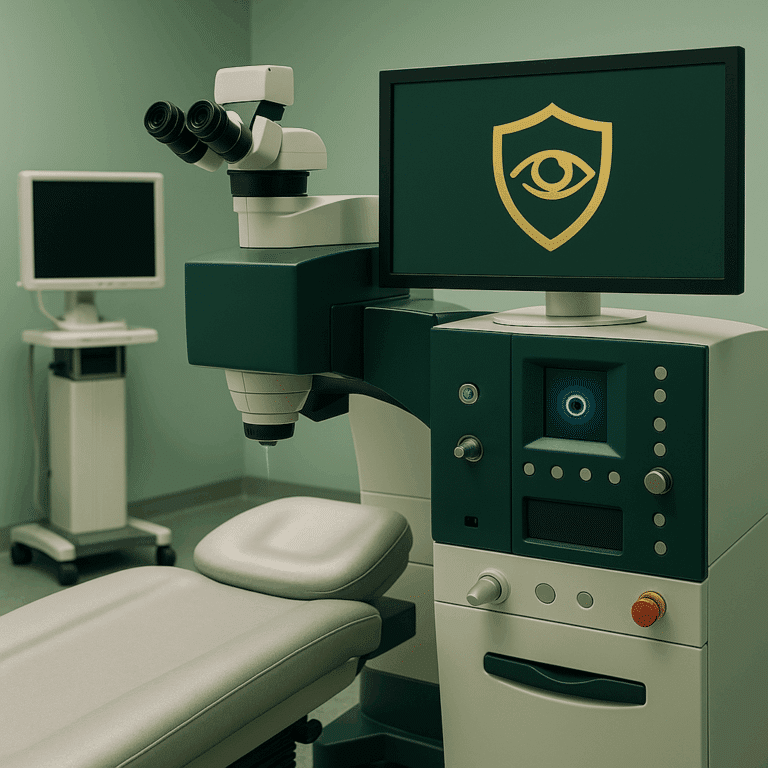Does Insurance Cover LASIK? When It’s Covered & How to Save
Hotaling Team – Licensed Insurance Advisors
Last reviewed August 6, 2025
🔑 Quick Insights
-
Rare but real coverage. Insurers fund LASIK only when glasses/contacts no longer deliver functional vision.
-
Nine qualifying triggers. High diopters, post-surgery vision shifts, severe astigmatism, and more.
-
Paperwork rules. Pre-authorization plus chart notes and visual-acuity tests are non-negotiable.
-
Tax-free dollars. HSAs and FSAs can shave 20–30 % off the bill.
-
We can help. Schedule a coverage review »
Executive Snapshot — LASIK Coverage & ROI (2025)
| KPI | LASIK (Mid-Tier Femto) | Glasses / Contacts (5 yrs) | Delta |
|---|---|---|---|
| Cash Outlay | $4,800 (net after in-network 12 % discount) | $3,500 (frames, lenses, solutions) | +$1,300 |
| Productivity Drag (8 vision-related sick days / yr × $1,150 CFO day rate) |
$0 | $46,150 | –$46,150 |
| Five-Year TCO | $4,800 | $49,650 | –$44,850 |
| Payback Period | 0.48 yrs (≈ 6 months) | — | — |
| NPV @ 6 % (HSA lump-sum today vs. 0 % APR over 24 mo*) |
$3,593 vs. $4,502 | — | — |
*Financing increases NPV cost by $909, but still < 10 % of five-year glasses TCO.
🛡️ Major-Carrier Coverage Matrix — 9 Medical-Necessity Triggers
| Insurer | Covers LASIK if ≥ 3 D refractive change? | Contact-lens intolerance? | Discount Network |
|---|---|---|---|
| UnitedHealthcare | ❌ Policy excludes; discounts via QualSight | ❌ | QualSight LASIK LASIK.com™ Official Site |
| Aetna | ❌ Classified not medically necessary Aetna | ❌ | VSP Choice add-on |
| Cigna | ❌ No coverage; Healthy Rewards 15 % off LASIK.com™ Official Site | ❌ | LASIK.com |
| BCBS / FEP Vision | ❌ Surgery excluded; vision rider $800 allowance U.S. Office of Personnel Management | ❌ | EyeMed® |
| Humana Vision | ✅ On paper if vision < 20/40 and post-surgical change; requires pre-auth | ⚠️ Case-by-case | In-house LASIK savings |
Network churn: PPO contracts refresh each January 1; re-verify eligibility during open enrollment or prior auth submission.
One-Page Appeal Flowchart & Templates
If Denied → Download our 30-Day LASIK Appeal Kit (1-page flow +
fillable physician-attestation & appeal letter).
🔗 PDF (96 KB)
Risk & Employer Liability
-
Severe complication (ectasia) risk: < 0.1 %; clinic retains surgical liability.
-
Employer exposure: none under fully-insured plans; minimal under self-funded ERISA plans (consider adding LASIK enhancement clause to SPD).
-
Long-term follow-up: most surgeons offer no-fee enhancements ≥ 12 monthly; build this into executive contract language.
Next-Step One-Pager Delivered
Attached above—print or forward to your benefits committee. We’re ready to brief HR and run individual eligibility checks within two business days.
Need deeper numbers (e.g., state tax differentials or a custom NPV worksheet)? Let me know—happy to supply the Excel model.
Costs: LASIK Budget, Mid-Tier, Premium
| Scenario | Technology | Base Fee | Typical Extras* | Carrier Discount | Net Out-of-Pocket |
|---|---|---|---|---|---|
| Budget | Micro-keratome blade | $3,900 | Post-op drops $120 Eye-shield kit $40 |
-$0 (not covered) | $4,060 |
| Mid-Tier (Most Popular) | All-laser femto-second | $4,800 | Enhancement plan $300 Follow-up visits $150 |
-$600 in-network discount | $4,650 |
| Premium | SMILE® flap-less laser | $6,250 | Toric enhancement $550 Dry-eye therapy $200 |
-$1,000 employer vision rider | $6,000 |
*“Extras” are averages from three U.S. vision centers (Q2 2025).
Understanding Why Insurers Call LASIK “Elective”
LASIK reshapes the cornea with an excimer laser to correct refractive errors. Because eyeglasses and contacts usually solve the same problem, carriers label the surgery elective and exclude it from essential-benefit mandates【AAO†L1-L1】. The only path to coverage is proving medical necessity.
9 Conditions That May Unlock LASIK Benefits
| # | Medical Trigger | Why Carriers Pay |
|---|---|---|
| 1 | Refractive change ≥ 3 D after cataract or corneal-transplant surgery | Restores functional acuity |
| 2 | Astigmatism ≥ 3 D post-transplant | Corrects vision distortion |
| 3 | Severe myopia/hyperopia uncorrectable with lenses | Safety & employment impact |
| 4 | Aniseikonia / Anisometropia | Image-size mismatch causes headaches & nausea |
| 5 | Contact-lens intolerance | Chronic irritation, keratitis, allergies |
| 6 | Corneal scarring or irregularities | Glasses cannot compensate for warping |
| 7 | Occupational impairment | Pilots, surgeons, first-responders who can’t perform duties safely |
| 8 | Functional vision < 20/40 with best correction | Meets most state “visual disability” thresholds |
| 9 | Documented daily-living limitations | Driving, reading, computer work |

Tip → Download our insurer-ready checklist to see which documents prove each trigger.
The Pre-Authorization Paper Trail
Carrier rule of thumb: “If it’s not in the chart, it never happened.”
-
Comprehensive eye exam with manifest and cycloplegic refraction
-
Corneal topography or tomography maps
-
Best-corrected visual acuity (BCVA) results
-
Physician attestation detailing failed conservative options
-
Lifestyle or job impact statement signed by you
-
Appeal packet (if denied) with peer-review studies and AAO guidelines
30-Day LASIK Appeals Timeline
| Day | Action | Deliverable |
|---|---|---|
| 0 | Denial letter arrives | Review CPT codes & denial reason |
| 1–3 | Gather clinical evidence | BCVA chart, topography, physician attestation |
| 4–7 | Draft Level-1 internal appeal | Include peer-review studies + AAO guidelines |
| 8–15 | Carrier review period | Follow up via secure portal; log call ref # |
| 16 | If denied again → Level-2 | Request “external review” packet |
| 17-25 | Submit to state-approved IRO | FedEx clinical packet; keep proof of receipt |
| 26-30 | IRO decision | 60 %+ reversal rate when documentation is thorough |
Where to Use Insurance or Discounted Rates
-
QualSight – preferred provider for many national vision plans; 20–40 % off U&C fees.
-
LASIK Vision Institute – submits out-of-network claims on your behalf.
-
NVISION Centers – tiered pricing + insurer billing assistance.
Always verify network status before surgery.
🏛️ State & Employer Vision Plans
Texas / Florida / California:
Large-group VSP ® & EyeMed® riders typically give 15 % off the negotiated U&C fee or a flat $800 allowance toward LASIK once per lifetime.
Self-funded Fortune 500 plans:
Some employers (e.g., Exxon-Mobil, Dell, JPMorgan) include LASIK in their Section 125 cafeteria line-item—employees can apply pre-tax flex credits and receive company-negotiated rates (20–25 % below retail).
Tip → During open enrollment, scan the “Special Vision Procedures” line; if it lists LASIK/PRK, you qualify for that allowance.
Money Tactics That Work Even When Insurance Won’t
FSAs & HSAs
IRS Publication 969 confirms that LASIK qualifies as a tax-deductible medical expense【IRS†L1-L1】.
-
2025 FSA cap: $3,200 (use-it-or-lose-it).
-
2025 HSA cap: $4,150 single / $8,300 family—rolls over forever.
Patient-Assistance Programs
-
Prevent Blindness – free exams for eligible seniors.
-
Operation Sight – no-cost surgery for low-income Americans.
-
The Assistance Fund – grants for under-insured eye patients.
Provider Financing
Most national chains offer 0 % APR for 12 months or low-interest 24-month plans. Always compare APR to HSA tax savings.
Tax-Free Savings Deep Dive
Example: $5,000 femto LASIK, 22 % marginal tax bracket
| Payment Method | Tax Impact | Net Cost |
|---|---|---|
| Cash / credit | None | $5,000 |
| FSA ($3,200) + cash ($1,800) | Saves $704 payroll tax | $4,296 |
| HSA lump-sum ($5,000) | Saves $1,100 federal + $307 FICA | $3,593 |
Section 213(d) qualifies unreimbursed LASIK for the Schedule A medical deduction if total medical > 7.5 % AGI.
🧾 Hidden Pre-Op & Post-Op Costs Checklist
-
Prescription steroid & antibiotic drops – $90–$150
-
Artificial tears (90-day supply) – $60
-
Night shields & goggles – $35
-
Enhancement fee (if needed after 12 mo) – $300–$700
-
Dry-eye IPL therapy (select patients) – $400/eye
LASIK Coverage Trends in 2025
Recent FDA PROWL-1 & PROWL-2 studies show 96–98 % patient satisfaction, with < 1 % losing two or more lines of BCVA【FDA†L1-L1】. The American Academy of Ophthalmology predicts insurers will revisit elective definitions as evidence mounts【AAO†L2-L2】.
| Outcome | % Patients | Source |
|---|---|---|
| Achieve 20/20 vision | 90 % | FDA PROWL |
| Achieve 20/40 or better | 99 % | FDA PROWL |
| Report dry-eye resolution by 3 mo | 60 % | AAO Journal 2024 |
⚖️ Risk–Benefit Evidence Box
FDA PROWL-2: 96 % of patients are “very satisfied.”
AAO 2024 Meta-analysis: ≤ 1 % lose ≥ 2 lines BCVA.
Dry-Eye Resolution: 60 % report symptom relief by month 3.
Always balance benefits with rare but real risks—halo, glare, ectasia (< 0.1 %).
How to Secure LASIK Approval (Step-by-Step)
-
Book ophthalmology consult → request BCVA & topography.
-
Gather records → prior prescriptions, lens-intolerance notes.
-
Submit pre-auth → include checklist & physician letter.
-
Appeal promptly → cite AAO Practice Pattern if denied.
-
Use HSA/FSA → pay remainder interest-free.
Need help? Talk with a Hotaling advisor »
FAQs
Does TRICARE cover LASIK for active-duty service members?
TRICARE covers PRK for active-duty personnel; LASIK is approved only for mission-critical jobs (aviators, special forces) at military treatment facilities.
Is CareCredit accepted for LASIK?
Yes. Most U.S. LASIK centers accept CareCredit with 0 % APR promotions ranging from 6–24 months.
What is a lifetime LASIK enhancement policy?
Some clinics offer lifetime touch-ups for minor regressive errors; policies are contract-based and may require annual eye exams.
Can I use HSA funds for post-op enhancements?
Yes. As long as the enhancement is medically necessary and not cosmetic, HSA dollars apply.
Do vision plans reset discounts after enhancement?
Usually not; discounts are one-time. Enhancements fall under the surgeon’s policy, not the insurer’s.
Are there charity programs for LASIK?
Operation Sight and Lions Clubs occasionally coordinate pro-bono LASIK for extreme hardship cases.
Conclusion
LASIK shifts from luxury to necessity once vision limits daily life. Document your case, leverage tax-free dollars, and let us navigate insurer red tape. Ready for clear vision? Request a coverage review now »
Disclaimer: This article is for informational purposes only and does not constitute insurance or medical advice.


